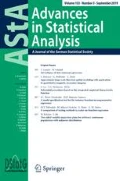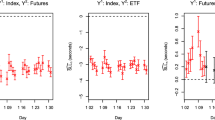Summary
Owing to enormous advances in data acquisition and processing technology the study of high (or ultra) frequency data has become an important area of econometrics. At least three avenues of econometric methods have been followed to analyze high frequency financial data: Models in tick time ignoring the time dimension of sampling, duration models specifying the time span between transactions and, finally, fixed time interval techniques. Starting from the strong assumption that quotes are irregularly generated from an underlying exogeneous arrival process, fixed interval models promise feasibility of familiar time series techniques. Moreover, fixed interval analysis is a natural means to investigate multivariate dynamics. In particular, models of price discovery are implemented in this venue of high frequency econometrics. Recently, a sound statistical theory of ‘realized volatility’ has been developed. In this framework high frequency log price changes are seen as a means to observe volatility at some lower frequency.
Similar content being viewed by others
References
Admati, A. R., Pfleiderer, P. (1988). A theory of intraday patterns: Volume and price variability. Review of Financial Studies 1 3–40.
Aït-Sahalia, Y., Mykland, P. A., Zhang, L. (2005). Ultra high frequency volatility estimation with dependent microstructure noise. National Bureau of Economic Research, Paper in Asset Pricing, Working Paper No. 11380.
Andersen, T. G., Bollerslev, T., Diebold, F. X. (2005). Parametric and nonparametric volatility measurement. In Handbook of Financial Econometrics (L. P. Hansen, Y. Aït-Sahalia, eds.), forthcoming. North Holland, Amsterdam.
Andersen, T. G., Bollerslev, T., Diebold, F. X., Ebens, H. (2001). The distribution of realized stock return volatility. Journal of Financial Economics 61 43–76.
Andersen, T. G., Bollerslev, T., Diebold, F. X., Labys, P. (2001). The distribution of realized exchange rate volatility. Journal of the American Statistical Association 96 42–55.
Andersen, T. G., Bollerslev, T., Diebold, F. X., Labys, P. (2003). Modeling and forecasting realized volatility. Econometrica 71 579–625.
Andersen, T. G., Bollerslev, T., Diebold, F. X., Wu (2004). Realized beta: Persistence and predictability. Northwestern University, Duke University and University of Pennsylvania, Manuscript.
Back, K. (1991). Asset pricing for general processes. Journal of Mathematical Economics 20 371–395.
Barndorff-Nielsen, O. E., Shephard, N. (2002a). Econometric analysis of realized volatility and its use in estimation stochastic volatility models. Journal of the Royal Statistical Society, Series B 64 253–280.
Barndorff-Nielsen, O. E., Shephard, N. (2002b). Estimating quadratic variation using realized variance. Journal of Applied Econometrics 17 457–477.
Barndorff-Nielsen, O. E., Shephard, N. (2004). Econometric analysis of realized covariation: High frequency based covariance, regression and correlation in financial economics. Econometrica 72 885–925.
Barndorff-Nielsen, O. E., Shephard, N. (2005). How accurate is the asymptotic approximation to the distribution of realized volatility?. In Identification and Inference for Econometric Models: Essays in Honor of Thomas Rothenberg (D. W. F. Andrews, J. H. Stock, eds.), Cambridge University Press, Cambridge.
Black, F. (1976). Studies of stock market volatility changes. Proceedings of the American Statistical Association, Business and Economic Statistics Section 177–181.
Bollerslev, T. (1986). Generalized autoregressive conditional heteroskedasticity. Journal of Econometrics, 31 307–327.
Bollerslev, T. (1987). A conditional heteroscedastic time series model for speculative prices and rates of return. Review of Economics and Statistics 69 542–547.
Dacorogna, M. M., Müller, U. A., Nagler, R. J., Olsen, R. B., Pictet, O. V. (1993). A geographical model for the daily and weekly seasonal volatility in the foreign exchange market. Journal of International Money and Finance 12 413–438.
de Jong, F., Nijman, T. (1997). High-frequency analysis of lead-lag relationships between financial markets. Journal of Empirical Finance 4 187–212.
de Jong, F., Mahieu R., Schotman P. (1998). Price discovery in the foreign exchange market: An empirical analysis of the Yen/Dmark rate. Journal of International Money and Finance 17 5–27.
Easley, D., O'Hara, M. (1992). Time and the process of security price adjustment. Journal of Finance 19 69–90.
Engle, R. F. (1982). Autoregressive conditional heteroskedasticity with estimates of the variance of U.K. inflation. Econometrica 50 987–1008.
Engle, R. F., Gonzalez-Rivera, G. (1991). Semiparametric ARCH models. Journal of Business an Economic Statistics 9 435–459.
Engle, R. F., Granger, C. W. J. (1987). Co-integration and error correction: Representation, estimation and testing. Econometrica 55 251–276.
Engle, R. F., Russell, J. R. (1998). Autoregressive conditional duration: A new model for irregularly spaced data. Econometrica 66 1127–1162.
Engle, R. F., Russell, J. R. (2005). Analysis of high frequency financial data. In Handbook of Financial Econometrics (L. P. Hansen, Y. Aït-Sahalia, eds.), forthcoming. North Holland, Amsterdam.
Frijns, B., Schotman, P. (2003) Price discovery in tick time. Limburg Institute of Financial Economics LIFE, Working Paper 03-024.
Ghysels, E., Gouriéroux, C., Jasiak, J. (1997). Market time and asset price movements: Theory and estimation. In Statistics in Finance (D. Hand, S. Jacka, eds.), 307–332. Edward Arnold London.
Goodhart, C. A. E., O'Hara, M. (1997). High frequency data in financial markets: Issues and applications. Journal of Empirical Finance 4 73–114.
Goodhart, C. A. E., Hall, S. G., Henry, S. G. B., Pesaran B. (1993). News effects in a high frequency model of the Sterling-Dollar exchange rate. Journal of Applied Econometrics 8 1–13.
Grammig, J., Melvin, M., Schlag, C. (2005). Internationally cross-listed stock prices during overlapping trading hours: Price discovery and exchange rate effects. Journal of Empirical Finance 12 139–164.
Granger, C. W. J. (1980). Testing for causality: A personal viewpoint. Journal of Economic Dynamics and Control 2 329–352.
Hansen, P. R., Lunde, A. (2004). An unbiased measure of realized variance. Brown University, Working Paper.
Harris, F. H. DeB., Shoesmith, G. L., McInish, T. H., Wood, R. A. (1995). Cointegration, error correction, and price discovery on informationally linked security markets. Journal of Financial and Quantitative Analysis 30 563–579.
Hasbrouck, J. (1995). One security, many markets, determining the contributions to price discovery. Journal of Finance 50 1175–1199.
Herwartz, H. (2001). Investigating the JPY/DEM rate: Arbitrage opportunities and a case for asymmetry. International Journal of Forecasting 17 231–245.
Huang R. D. (2002). The quality of ECN and market maker quotes. Journal of Finance 57 1285–1319.
Johansen, S. (1995). Likelihood-based inference in cointegrated vector autoregressive models. Oxford University Press, Oxford.
Jones R. H. (1980). Maximum likelihood fitting of ARMA models to time series with missing observations. Technometrics 22 389–395.
Jordà, Ò., Marcellino, M. (2003) Modeling high-frequency foreign exchange data dynamics. Macroeconomic Dynamics 7 618–635.
Karpoff, J. M. (1987). The relation between price changes and trading volume: A survey. Journal of Financial and Quantitative Analysis 22 109–26.
Kohn, R., Ansley, C. F. (1986). Estimation, prediction, and interpolation for ARIMA models with missing data. Journal of the American Statistical Association 81 751–761.
Lo, M. C., Zivot, E. (2001). Threshold cointegration and nonlinear adjustment to the low of one price. Macroeconomic Dynamics 5 533–576.
Lütkepohl, H. (1991). Introduction to Multiple Time Series Analysis. Springer, Berlin.
Nelson, D. B. (1990). ARCH models as diffusion approximations. Journal of Econometrics 45 7–39.
Merton, R. (1973). Theory of rational option pricing. Bell Journal of Economics and Management Science 4 141–183.
Oomen, R. C. (2003). Three Essays on the Econometric Analysis of High Frequency Financial Data. European University Institute, Ph. D. thesis.
Protter, P. (1990). Stochastic Integration and Differential Equations: A New Approach. Springer, New York.
Schreiber, P. S., Schwartz, R. A. (1986). Price discovery in securities markets. Journal of Portfolio Management 12 43–48.
Schwert, G. W. (1989) Why does stock market volatility change over time? Journal of Finance 44 1115–1153.
Schwert, G. W. (1990). Stock volatility and the crash of '87. Journal of Financial Studies 3 77–102.
Taylor, S. J. (1986). Modeling financial time series. John Wiley, Chichester.
Teräsvirta T. (1994). Specification, estimation, and evaluation of smooth transition autoregressive models. Journal of the American Statistical Association 89 208–218.
White, H. (1984). Asymptotic Theory for Econometricians. Academic Press, Orlando.
Zhang, L., Mykland, P. A., Aït-Sahalia, Y. (2005). A tale of two time scales: Determining integrated volatility with noisy high-frequency data. Journal of the American Statistical Association (forthcoming).
Author information
Authors and Affiliations
Rights and permissions
About this article
Cite this article
Herwartz, H. Econometric analysis of high frequency data. Allgemeines Statistisches Arch 90, 89–104 (2006). https://doi.org/10.1007/s10182-006-0223-3
Received:
Revised:
Issue Date:
DOI: https://doi.org/10.1007/s10182-006-0223-3




